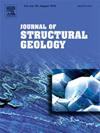Controlling factors of Riedel shear spacing in the simple shear mode of strike-slip fault: Insights from sandbox models
IF 2.9
2区 地球科学
Q2 GEOSCIENCES, MULTIDISCIPLINARY
引用次数: 0
Abstract
Strike-slip faults generally develop Riedel shears (R-shears), which exhibit parallel and evenly-spaced distribution characteristics. However, the factors controlling the R-shear spacing in strike-slip faults are still unclear. The influence of material properties such as internal friction angle and cohesion, basal friction, and the thickness of brittle layers (T) on the R-shear spacing (S) are investigated using analogue models in this paper. Research findings indicate that the internal friction angle of the material and the thickness of the brittle layer have a significant impact on the R-shear spacing, with the thickness of the brittle layer directly determining the R-shear spacing as evidenced by their linear correlation. In comparison, cohesion and basal friction have insignificant effects on R-shear spacing. Based on this, experiments were carried out using various thicknesses of brittle layers (specified materials) to investigate the impact of the brittle layer thickness on the R-shear spacing, and Particle Image Velocimetry (PIV) is used to analyze the distribution pattern of R-shear development at each stage. The results indicate that fractures occur in regions where the vorticity field alternates between positive and negative values, and as the evolution progresses, the maximum strain gradually converges towards the center of the deformation zone, leading to a reduction in the activity of the R-shear, while the spacing of the R-shear remains unaltered. The normalized (S/T) results indicate that the experimental value of 1.32 aligns with natural laws and is very close to the normalized value of the natural faults, which is 1.24. It can be inferred that the thickness of the seismogenic crust within the range of the Altyn Tagh Fault is 40.9–43.5 km.
走向滑动断层简单剪切模式中里德尔剪切间距的控制因素:沙盘模型的启示
走向滑动断层一般会产生里德尔剪切(R-shears),表现出平行且间距均匀的分布特征。然而,控制走向滑动断层中 R 型剪切间距的因素仍不明确。本文利用模拟模型研究了内摩擦角和内聚力、基底摩擦力和脆性层厚度(T)等材料特性对 R-shear 间距(S)的影响。研究结果表明,材料的内摩擦角和脆性层的厚度对 R-shear 间距有显著影响,其中脆性层的厚度直接决定了 R-shear 间距,它们之间的线性相关关系证明了这一点。相比之下,内聚力和基底摩擦力对 R-shear 间距的影响不大。在此基础上,使用不同厚度的脆性层(指定材料)进行实验,研究脆性层厚度对 R-shear 间距的影响,并使用粒子图像速度仪(PIV)分析每个阶段 R-shear 发展的分布模式。结果表明,断裂发生在涡度场正值和负值交替出现的区域,随着演化的进行,最大应变逐渐向变形区中心靠拢,导致 R 形剪切活动减弱,而 R 形剪切间距保持不变。归一化(S/T)结果表明,实验值 1.32 符合自然规律,与自然断层的归一化值 1.24 非常接近。由此可以推断,Altyn Tagh 断层范围内的地震成因地壳厚度为 40.9-43.5 千米。
本文章由计算机程序翻译,如有差异,请以英文原文为准。
求助全文
约1分钟内获得全文
求助全文
来源期刊

Journal of Structural Geology
地学-地球科学综合
CiteScore
6.00
自引率
19.40%
发文量
192
审稿时长
15.7 weeks
期刊介绍:
The Journal of Structural Geology publishes process-oriented investigations about structural geology using appropriate combinations of analog and digital field data, seismic reflection data, satellite-derived data, geometric analysis, kinematic analysis, laboratory experiments, computer visualizations, and analogue or numerical modelling on all scales. Contributions are encouraged to draw perspectives from rheology, rock mechanics, geophysics,metamorphism, sedimentology, petroleum geology, economic geology, geodynamics, planetary geology, tectonics and neotectonics to provide a more powerful understanding of deformation processes and systems. Given the visual nature of the discipline, supplementary materials that portray the data and analysis in 3-D or quasi 3-D manners, including the use of videos, and/or graphical abstracts can significantly strengthen the impact of contributions.
 求助内容:
求助内容: 应助结果提醒方式:
应助结果提醒方式:


